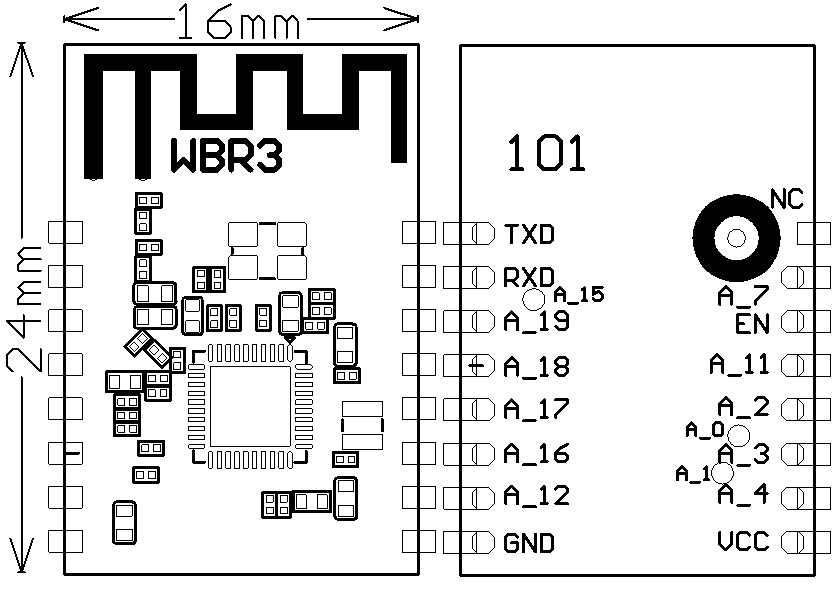
WBR3 is a low-power embedded Wi-Fi+BT module that Tuya has developed. It consists of a highly integrated RF chip (RTL8720CF), with an embedded Wi-Fi network protocol stack and varied library functions.
With the maximum CPU clock rate of 100MHz, WBR3 also contains a low-power KM4 microcontroller unit (MCU), WLAN MAC, a 1T1R WLAN module, 256-KB static random-access memory (SRAM), 2-MB flash memory, and extensive peripherals.
WBR3 is an RTOS platform that integrates all function libraries of the Wi-Fi MAC and TCP/IP protocols. You can develop embedded Wi-Fi products as required.
| Date | Description | Version after change |
|---|---|---|
| 10/21/2019 | This is the first release. | V1.0.0 |
As shown in the following figure, WBR3 has two rows of pins and each row includes 8 pins with a 2 mm pin spacing. The WBR3 dimensions (H x W x L) are 2.9 mm x 16 mm x 24 mm. The default dimensional tolerance is ±0.35 mm.

| Pin Number | Symbol | I/O Type | Function |
|---|---|---|---|
| 1 | NC | / | The pin is pulled up to be compatible with other modules |
| 2 | A_7 | I/O | GPIOA_7, hardware PWM, IC Pin 21 |
| 3 | EN | I/O | Enabling pin, which works at the high level and is pulled up and controlled by a user externally |
| 4 | A_11 | I/O | GPIOA_11, hardware PWM, IC Pin 25 |
| 5 | A_2 | I/O | GPIOA_2, hardware PWM, IC Pin 18 |
| 6 | A_3 | I/O | GPIOA_3, hardware PWM, IC Pin 19 |
| 7 | A_4 | I/O | GPIOA_4, hardware PWM, IC Pin 20 |
| 8 | VCC | P | Power supply pin (3.3V) |
| 9 | GND | P | Power supply reference ground |
| 10 | A_12 | I/O | GPIOA_12, hardware PWM, IC Pin 26 |
| 11 | A_16 | I/O | GPIOA_16, UART_Log_TXD, which is used for displaying the module internal information and can be configured as a common GPIO |
| 12 | A_17 | I/O | GPIOA_17, hardware PWM, IC Pin 38 |
| 13 | A_18 | I/O | GPIOA_18, hardware PWM, IC Pin 39 |
| 14 | A_19 | I/O | GPIOA_19, hardware PWM, IC Pin 40 |
| 15 | RXD | I/O | GPIOA_13, UART0_RXD, which is used as a user-side serial interface pin |
| 16 | TXD | I/O | GPIOA_14, UART0_TXD, which is used as a user-side serial interface pin |
Note:: P indicates power supply pins and I/O indicates input/output pins.
| Parameter | Description | Minimum value | Maximum value | Unit |
|---|---|---|---|---|
| Ts | Storagetemperature | -40 | 105 | ℃ |
| VDD | Power supply voltage | -0.3 | 3.6 | V |
| Static electricity voltage (human body model) | TAMB-25℃ | - | 2 | KV |
| Static electricity voltage (machine model) | TAMB-25℃ | - | 0.5 | KV |
| Parameter | Description | Minimum value | Typical value | Maximum value | Unit |
|---|---|---|---|---|---|
| Ta | Working temperature | -20 | - | 85 | ℃ |
| VDD | Power supply voltage | 3.0 | - | 3.6 | V |
| VIL | I/O low-level input | - | - | 0.8 | V |
| VIH | I/O high- level input | 2.0 | - | - | V |
| VOL | I/O low-level output | - | - | 0.4 | V |
| VOH | I/O high-level output | 2.4 | - | - | V |
| Imax | I/O drive current | - | - | 16 | mA |
| Cpad | Input pin capacitance | - | 2 | - | pF |
TX power consumption:
| Symbol | Mode | Power | Average value | Peak value (Typical value) | Unit |
|---|---|---|---|---|---|
| IRF | 11b 11 Mbps | 17 dBm | 217 | 268 | mA |
| IRF | 11b 11 Mbps | 18 dBm | 231 | 283 | mA |
| IRF | 11g 54 Mbps | 15 dBm | 159 | 188 | mA |
| IRF | 11g 54 Mbps | 17.5 dBm | 177 | 213 | mA |
| IRF | 11n BW20 MCS7 | 13 dBm | 145 | 167 | mA |
| IRF | 11n BW20 MCS7 | 16.5 dBm | 165 | 193 | mA |
RX power consumption:
| Symbol | Mode | Average value | Peak value (Typical value) | Unit |
|---|---|---|---|---|
| IRF | 11B 11M | 63 | 65 | mA |
| IRF | 11G 54M | 65 | 67 | mA |
| IRF | 11N HT20 MCS7 | 65 | 67 | mA |
| Working Mode | Working Status (Ta = 25°C) | Average value | Peak value (Typical value) | Unit |
|---|---|---|---|---|
| Quick connection network status | The module is in the fast network configuration state, Wi-Fi | 75 | 324 | mA |
| Network connection idle state | The module is connected to the network and the Wi-Fi indicator is always on | 64 | 314 | mA |
| Network connection operation status | The module is connected to the network, Wi-Fi | 66 | 305 | mA |
| Disconnected status | The module is offline and the Wi-Fi indicator is dark | 66 | 309 | mA |
| Parameter | Description |
|---|---|
| Frequency range | 2.400 to 2.4835 GHz |
| Wi-Fi standard | IEEE 802.11b/g/n (channels 1 to 14) |
| Bluetooth LE standard | Bluetooth 4.2 |
| Data transmission rate | 11b: 1, 2, 5.5, 11 (Mbps) |
| Data transmission rate | 11g: 6, 9, 12, 18, 24, 36, 48, 54 (Mbps) |
| Data transmission rate | 11n: HT20 MC S 0 to 7 |
| Antenna Type | PCB antenna with a gain of 2.5 dBi |
| Parameter | Minimum value | Tyical value | Maximum value | Unit |
|---|---|---|---|---|
| Average RF output power, 802.11b CCK Mode, 1 Mbit/s | - | 17.5 | - | dBm |
| Average RF output power, 802.11g OFDM mode, 54 Mbit/s | - | 14.5 | - | dBm |
| Average RF output power, 802.11n OFDM mode MCS7 | - | 13.5 | - | dBm |
| Average RF output power, Bluetooth LE 4.2, 1 Mbit/s | - | 6.5 | - | dBm |
| Frequency error | -20 | - | 20 | ppm |
| EVM@802.11b CCK 11 Mbps Mode 17.5 dBm | - | - | -10 | dB |
| EVM@802.11g OFDM 54 Mbps Mode 14.5 dBm | - | - | -29 | dB |
| EVM@802.11n OFDM MCS7 Mode 13.5 dBm | - | - | -30 | dB |
| Parameter | Minimum value | Typical value | Maximum value | Unit |
|---|---|---|---|---|
| PER<8%, RX sensitivity, 802.11b CCK Mode 1M | - | -97 | - | dBm |
| PER<10%, RX sensitivity, 802.11g OFDM Mode 54M | - | -75 | - | dBm |
| PER<10%, RX sensitivity, 802.11n OFDM Mode MCS7 | - | -72 | - | dBm |
| PER<10%, RX sensitivity, Bluetooth LE 4.2 1M | - | -93 | - | dBm |
WBR3 uses an onboard PCB antenna with a gain of 2.5 dBi.
To ensure optimal Wi-Fi performance when the Wi-Fi module uses an onboard PCB antenna, it is recommended that the antenna be at least 15 mm away from other metal parts.
As shown in the following figure, the mechanical dimensions of the PCB of WBR3 are 16±0.35 mm (W)×24±0.35 mm (L) ×0.8±0.1 mm (H).
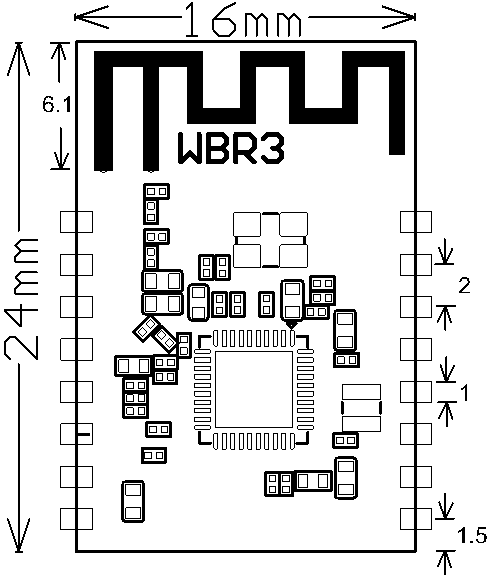
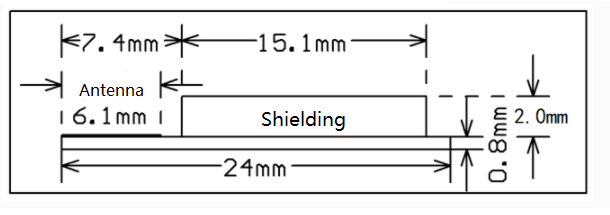
Note:: The default dimensional tolerance is ±0.35 mm. If you have specific requirements on dimensions, make them clear in the datasheet after communication.
The following figure is a schematic diagram of WBR3 which shows how pins correspond to each other.
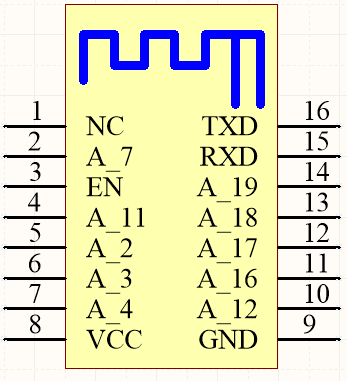
WBR3 PCB Layout is shown as below:
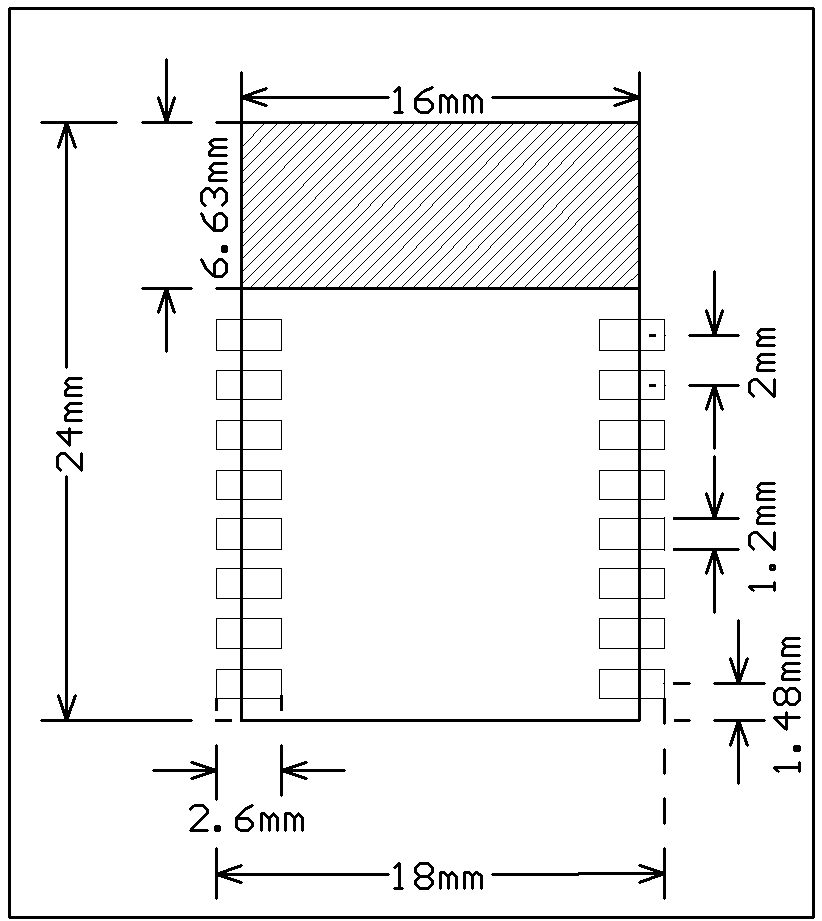
Tuya’s stamp hole package module must be mounted by an SMT machine, and the mounting must be completed within 24 hours after unpacking and programming of the firmware. Otherwise, it must be packaged again under vacuum. The module must be baked before mounting.
SMT equipment
Baking equipment
Storage conditions for a delivered module are as follows:
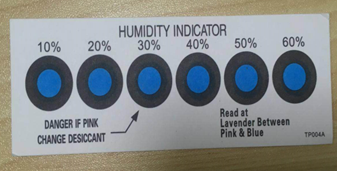
Bake a module based on HIC status as follows when you unpack the module package:
Baking settings:
Do not use SMT to process modules that have been unpacked for more than 3 months, because electroless nickel/immersion gold (ENIG) is used for PCBs and they are seriously oxidized after more than 3 months. SMT is very likely to cause pseudo and missing soldering. Tuya is not liable for such problems and consequences.
Before SMT, take electrostatic discharge (ESD) protective measures.
To reduce the reflow defect rate, draw 10% of the products for visual inspection and AOI before the first mounting to determine proper methods for controlling the oven temperature and attaching and placing components. Draw 5 to 10 modules from subsequent batches each hour for visual inspection and AOI.
Perform SMT based on the following reflow oven temperature curve. The highest temperature is 245°C. The reflow temperature curve is shown below:

Refer to IPC/JEDEC standard, the peak temperature is lesser than 245℃, and the number of times can not be greater than 2.
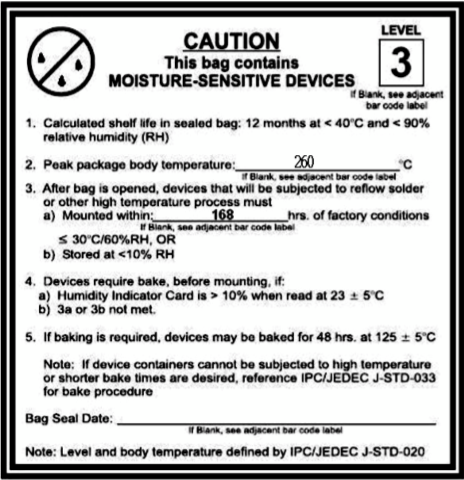
| Product number | MOQ (pcs) | Shipping packaging method | Modules per reel |
|---|---|---|---|
| WBR3 | 3600 | Tape reel | 900 |
FCC Caution: Any changes or modifications not expressly approved by the party responsible for compliance could void the user’s authority to operate this equipment.
This device complies with Part 15 of the FCC Rules. Operation is subject to the following two conditions: (1) This device may not cause harmful interference, and (2) this device must accept any interference received, including interference that may cause undesired operation.
Note: This equipment has been tested and found to comply with the limits for a Class B digital device, pursuant to part 15 of the FCC Rules. These limits are designed to provide reasonable protection against harmful interference in a residential installation. This equipment generates, uses, and can radiate radio frequency energy and, if not installed and used in accordance with the instructions, may cause harmful interference to radio communications. However, there is no guarantee that interference will not occur in a particular installation. If this equipment does cause harmful interference to radio or television reception, which can be determined by turning the equipment off and on, the user is encouraged to try to correct the interference by one or more of the following measures:
Radiation Exposure Statement
This equipment complies with FCC radiation exposure limits set forth for an uncontrolled rolled environment. This equipment should be installed and operated with a minimum distance of 20cm between the radiator and your body.
Important Note
This radio module must not be installed to co-locate and operating simultaneously with other radios in the host system except in accordance with FCC multi-transmitter product procedures. Additional testing and equipment authorization may be required to operate simultaneously with other radios.
The availability of some specific channels and/or operational frequency bands are country dependent and are firmware programmed at the factory to match the intended destination. The firmware setting is not accessible by the end-user.
The host product manufacturer is responsible for compliance to any other FCC rules that apply to the host not covered by the modular transmitter grant of certification. The final host product still requires Part 15 Subpart B compliance testing with the modular transmitter installed.
The end-user manual shall include all required regulatory information/warning as shown in this manual, including: This product must be installed and operated with a minimum distance of 20 cm between the radiator and user body.
This device has got an FCC ID: 2ANDL-WBR3. The final end product must be labeled in a visible area with the following: “Contains Transmitter Module FCC ID: 2ANDL-WBR3”.
This device is intended only for OEM integrators under the following conditions:
As long as the 2 conditions above are met, further transmitter tests will not be required. However, the OEM integrator is still responsible for testing their end-product for any additional compliance requirements required with this module installed.
Declaration of Conformity European notice

Hereby, Hangzhou Tuya Information Technology Co., Ltd declares that this module product is in compliance with essential requirements and other relevant provisions of Directive 2014/53/EU,2011/65/EU. A copy of the Declaration of conformity can be found at https://www.tuya.com.

This product must not be disposed of as normal household waste, in accordance with the EU directive for waste electrical and electronic equipment (WEEE-2012/19/EU). Instead, it should be disposed of by returning it to the point of sale, or to a municipal recycling collection point.